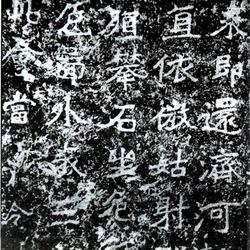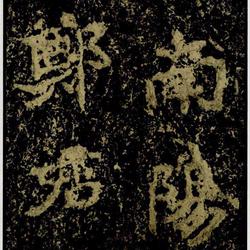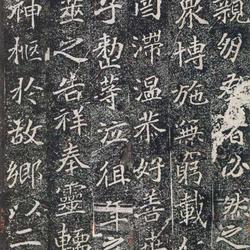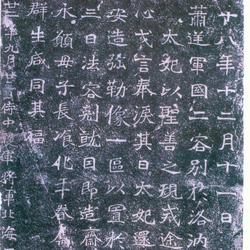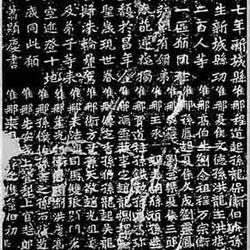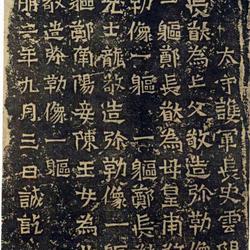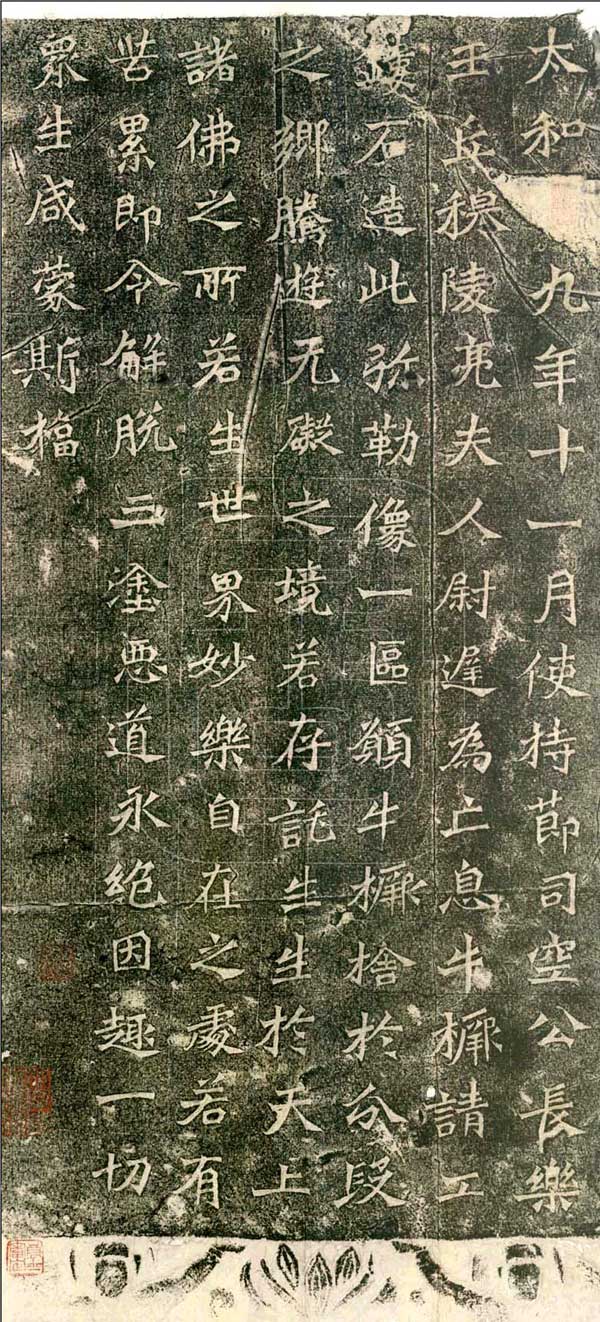
Rubbing version: Qing Daoguang rubbings Gu Qianli and Qu Yong collected rubbings
official book
Donated by Ding Huikang
The seal of the inscription and postscript is the seal of "Approval of Good Scholars"
Text of rubbings:
In November of the 19th year of Taihe, he sent an envoy to Chijie Sikong Gong, Changle King Qiu Mulingliang and his wife Yuchi to ask for a carving stone to build this Maitreya statue for the dead cow. If you are reborn in the world where the Buddhas in the sky are reborn, if there is any suffering and suffering, you will be liberated from the evil paths of the Three Realms and will never end their destiny. All sentient beings will receive blessings.
"The Record of the Statue of Niuzhu", whose full name is "The Record of the Statue of Maitreya Built by King Qiu Mulingliang and his wife Yuchi in honor of the deceased Niuzhu" in November of the 19th year of Taihe, is one of the twenty products of Longmen. It is 100 centimeters high and 34 centimeters wide. It was built by Yuchi (later changed to "Wei" surname), wife of Changle King Qiu Mulingliang, for her deceased son Niu Chu. In the past, it was known as the Niu Chu niche. There is a lotus carved in the middle of the statue base, and two strong men on the left and right raise their hands in a lifting gesture, which is a vivid and lifelike image. The font of the inscription is dignified and neat.
other information
The statue niche is on the north side of Guyang Cave, above the Yang Dayan niche. The niche is 140 cm high, 106 cm wide and 21 cm deep. It is in the shape of a round coupon. The lintel is engraved with eleven boys holding flower ropes. The boy is holding a lotus. There are lotus buds carved between the two boys. There is a flying sky at each end and a shallow carving in front of the flying head. Little Feitian. On the left and right below the lintel of the niche, there are donors dressed in Hu clothing. The main statue is a seated Maitreya wearing a crown and crossing his legs. It is the image of the Bodhisattva when Maitreya ascended to Tusita Heavenly Palace. The headlight is engraved with lotus flowers on the inside and seven seated Buddhas on the outside. The outer flame pattern of the backlit external ginseng is composed of seventeen groups of flame patterns with a seated Buddha as the center. The inner layer has ten flying gods on both sides facing each other and supported by necklaces. Two lions crouch under Maitreya's knees, with a strong man crossing their feet and holding Maitreya's feet in their hands.
Qiu Mulingliang's original surname was "Qiu Muling", but he changed his surname to "Mu" after Emperor Wu. Liangzi Youfu, who has been graceful for a long time, was the king of Zhaojun during the reign of Emperor Xianwen. According to the Records of Gaozu in the Book of Wei, Qiu Mulingliang was granted the title of King of Changle in the first year of Yanxing, and later moved to Chijie as an envoy to conquer the West. job. After Sizhou was established, he was promoted to Sizhou Dazhongzheng. During Emperor Xiaowen's expedition to the south, Emperor Xiaowen made Liang the Minister of Records and stayed in Luoyang, where he was favored by Emperor Gaozu. Later, he impeached himself because his brother had dismissed his duties, and moved to Dunqiu County (today's north of Puyang City, Henan Province) to be the Duke of Kaiguo. He died in the third year of Jingming (AD 502) at the age of 52. Liang had many official positions in his life. This statue is engraved with the positions of his most famous ones, "Shichijie", "Sikong Gong" and "Changle King", to show his glory. The statue was created around the time when Emperor Gaozu was on his southern expedition and Qiu Mulingliang stayed in Luoyang.
The statue is 100 centimeters high and 34 centimeters wide. It was built by Yuchi (later changed to "Wei" surname), wife of Changle King Qiu Mulingliang, for her deceased son Niu Chu. It was once known as the Niu Chu niche. There is a lotus carved in the middle of the statue base, and two strong men on the left and right raise their hands in a lifting gesture, which is a vivid and lifelike image. The font of the inscription is dignified and neat.

